Earlier this month, Ori Inbar posted on Games Alfresco about why people get excited about augmented reality. Ori mentions Vernor Vinge’s Rainbows End as inspiration and it got me thinking about other novels that use augmented reality.
I’m making this list, not only because these novels and stories are great reads, but also because I find it fascinating how fiction, especially science-fiction, can inspire real inventions. Who would have thought the social-media-karma concept of Whuffie from Cory Doctorow’s novel Down and Out in the Magic Kingdom would be made real (will it work is a whole ‘nother story)? Or how Google’s super-nerds Larry Page and Sergey Brin have taken notes from Neal Stephenson’s Snow Crash for their Google Earth project? The afore mentioned Rainbows End has frequently been called upon in the realms of augmented reality.
Without further ado (because when do you actual have ado?), I present, in no particular order, the augmented reality reading list (updated 9/21 and 9/22):
Novels
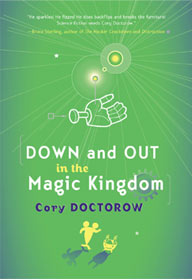 Down and Out in the Magic Kingdom – Cory Doctorow
Down and Out in the Magic Kingdom – Cory Doctorow
The novel is set in the 22nd century when death has been cured. While the jacket cover may baffle you by combining such concepts as Disney World, ad-hocracies, Whuffie and the Bitchun utopia, the story was nominated for a Nebula Award in 2004 for Best Novel, so that should tell you something for the quality of the writing. This is the only one on the list that I’ve read (besides Virtual Light), but its been one of my favorites for the last decade. The augmented reality concept within the novel is the HUD. It’s not quite the “shared reality” that true AR brings, but it definitely combines social-networking, the Internet and a HUD for the everyday man, woman or child.
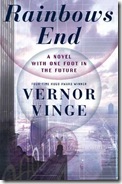 Rainbows End – Vernor Vinge
Rainbows End – Vernor Vinge
This novel is frequently cited among knowledgeable augmented reality enthusiasts as an inspiration for their work (along with Denno Coil). While many of the other stories in this list have only tantalizing connections to AR, Vernor has specifically written this novel with the technology as the backbone for society. It won the Hugo Award and Locus Awards in 2007.
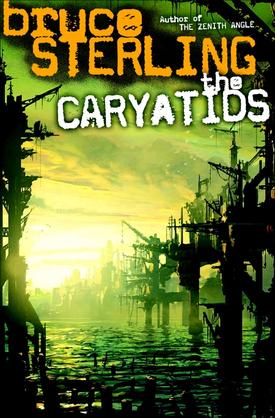 The Caryatids – Bruce Sterling
The Caryatids – Bruce Sterling
Our prophet of augmented reality, Bruce Sterling, is no stranger to this illusionary science. Long ago he helped pioneer the original cyberpunk revolution and has had elements of AR in his short stories and novels (i.e. Holy Fire) for some time. In his most recent novel, The Caryatids, he unleashes the technology in the form of Spex which are a form of head-mounted displays. Cory Doctorow gives a glowing review of the book on BoingBoing.
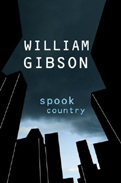 Spook Country – William Gibson
Spook Country – William Gibson
Gibson’s novel brings us geolocative art that can only be seen with VR helmets. It’s not entirely AR, but its close enough to draw similar conclusions. In a quote I like, which sums up the transition from cyberpunk to post-cyberpunk to augpunk (or whatever it should be called) Gibson says:
If the book has a point to make where we are now with cyberspace, is that cyberspace has colonized our everyday life and continues to colonize everyday life.
The novel was nominated for a Locus Award in 2008. You can read more about the novel in this SF Net Review.
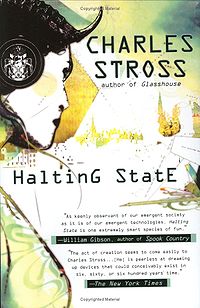 Halting State – Charles Stross
Halting State – Charles Stross
The novel’s plot centers around a bank robbery in an MMORG and is written in the second person. The AR in the novel is based on the usage of Specs, the same goggles in his novel Accelerando, that are a form of HUD. The novel was nominated for both a Hugo and a Locus in 2008 and has a sequel entitled “419” due out in 2010.
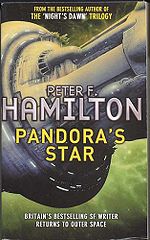 The Commonwealth Saga and Void Trilogy – Peter F. Hamilton
The Commonwealth Saga and Void Trilogy – Peter F. Hamilton
This arc of books starts in the near-future, then jumps forward 300 years before making its final jump to a period of 1200 years later for the void trilogy. Not all the books are finished (the last is due out in 2011.) The AR contained stretches a bit further than the others on this list with an interstellar network of computers called the Unisphere. While the others on the list are post-cyberpunk novels, this one is an epic space opera with elements of augmented reality.
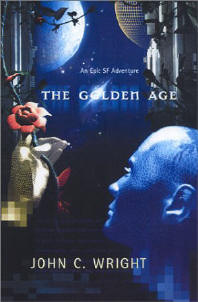 The Golden Age Trilogy – John C. Wright
The Golden Age Trilogy – John C. Wright
This trilogy is set 500,000 years into the future when everyone is immortal and wealthy. The elite Manorials rely on AI to do all the trivial day-to-day work for them while they interact with each other using the Mentality (their version of the Internet.) They commonly travel by telepresence (or augmented reality.)
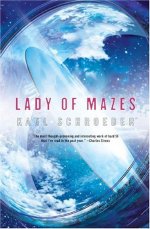 Lady of Mazes – Karl Schroeder
Lady of Mazes – Karl Schroeder
The novel is set in the far future similar to the above Golden Age. Post-humans have gained god-like powers and utilize AR to change their surroundings. SFSite gives a review of the novel here.
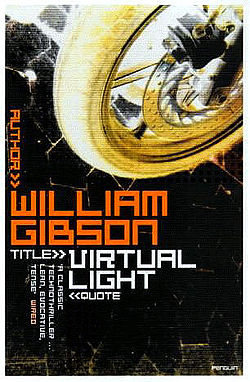 Virtual Light – William Gibson
Virtual Light – William Gibson
The plot centers around a young bike messanger who steals a pair of innocent-looking glasses from a man at a party. She doesn’t realize what they do, nor does she realize what dangerous information they have on them. The “virtual-light” glasses are obviously AR glasses (upon my 5th reading twenty years later), but its interesting how the data is very localized. The use of AR is limited (most of it doesn’t come until the end), but captures the essence of the technology. The novel was a finalist for the Hugo and Locus Awards.
 Uglies Trilogy – Scott Westerfield
Uglies Trilogy – Scott Westerfield
While this trilogy technically falls into the YA section, it’s not just for teenagers and I highly recommend it for everyone. Like Cory Doctorow’s Little Brother, the main character is in her teens and the far-future technology is second nature including hacking her interface ring and hoverboard. Augmented reality isn’t a main component of the storyline, but the privacy issues surrounding the Internet of Things is visible throughout. Even if you don’t care a lick about AR, I’d pick up these books. The story had me so completely in its grips I read all three books over a period of five days.
Short Stories/Novellas
Dogfight – William Gibson and Michael Swanwick
Deep Eddy – Bruce Sterling
Taklamakan – Bruce Sterling
Bicycle Repairman – Bruce Sterling
(These three Sterling stories are collected in A Good Old-Fashioned Future with a few others)
The Things That Make Me Weak and Strange Get Engineered Away – Cory Doctorow
Accelerando – Charles Stross
Sagan’s Law – Thomas K Carpenter (yes, that’s me! shameless self promotion.)
Special thanks to Bruce Sterling who was kind enough to take a break from opining about pink hoodies and the strange names of augmented reality to help me populate my meager list, especially the short stories. If you don’t read his blog on Wired, then you should. He posts more about augmented reality than is probably healthy for a human being.
Also, thanks to D. Cahill (Hamilton), Mike (Stross – I can’t believe I missed that one), Mike Scott (Schroeder), Blair MacIntyre (Gibson), and Johannes (Wright) for the other suggestions.
And if I’ve missed any books or short stories that involve augmented reality, I’ll be happy to update the list. So please comment here or send me an email.

Thanks for this list Thomas, I’ve read the first too, I’ll certainly look at the others. How come the Digital Sea is not on the list?!
EDIT: I misspelled “two”, grrr.
[…] about Boing Boing as of September 21, 2009 The Augmented Reality Reading List – thomaskcarpenter.com 09/21/2009 Earlier this month, Ori Inbar posted on Games Alfresco […]
Handy list – must look into that Rainbow’s End one in particular, only heard of it recently.
Peter F Hamilton’s novels also tend to contain a fair bit of AR (usually in the form on direct neural interfaces). It’s not a central story element or anything – just something the characters use as an everday tool, may be of interest though. His Commonwealth Saga novels feature an “e-butler” routinely used by most characters, which involves a good deal of AR/overlaid displays. May be of interest.
http://www.amazon.co.uk/Pandoras-Star-Commonwealth-Peter-Hamilton/dp/0330493310
Great list! Thanks!
I think that you should add Accelerando by Charles Stross to this list. The stories in the first part of the book are super-heavy on AR technology.
I’d actually like to oppose D Cahill suggestion of Peter Hamilton and Pandora’s Star. The books in that series are more an example of how AR will not actually work. If you have a direct neural interface, why the hell would you need “virtual hands” overlaid in your vision to press virtual buttons and move virtual joysticks? Weird.
@ David – Manuscript complete, but just started the agent search. Hoping spring 2010 if all goes to plan, but when does anything follow the plan?
@Cahill – read the wiki on Hamilton. Sounds a lot like AR to me. I’ll add it to the list. Good find!
@Mike – I agree wtih Accelerando, but I disagree with your opposition. AR isn’t about the interface device, its about the mixing of real-time graphics and reality. Thanks for the nod to Stross!
Don’t overlook Manchester writer Jeff Noon’s ‘Vurt’ (1993) – written during the Acid House craze in England, it’s very influenced by Ecstacy.
http://www.vurt-feather.co.uk/
Oh Accelerando is a great book I forgot about that. It’s not really a short story though, it is in fact quite long. 🙂
Add Lady of Mazes by Karl Schroeder, where AR is taken to extremes.
You hit Gibson, but missed “Virtual Light,” a very-AR book.
@ David – in the wiki it lists it as a collection of a few novellas. Could go either way I guess.
@ Blair – It’s been so long since I’ve read Virtual Light (and I’ve probably read it 3-4 times), its hard to remember. Give me a good reason to read it a 5th time then.
I’ll add all those later today when I’m more awake.
This may be stretching the VR / AR continuum a bit, but John C. Wright’s Golden Age trilogy takes place almost continuously in an AR world. The books are The Golden Age, The Phoenix Exultant, and The Golden Transcendence.
@ Johannes – added the Golden Age, looks very AR.
@culturecrammer – Vurt looks a bit more VR (a cross between Clockwork Orange and Neuromancer is a description I saw). So unless someone else has an opinion, I’ll leave it off for now.
@Blair – when I get home from work tonight I’m going to reread VL so I can get the AR part right for the description.
The proxnet/farnet/allnet ‘reading function’ as depicted in Dan Simmons books Illium and Olympos is in my opinion the hands-down best vision for an ideal AR application.
[…] 13) Rainbows’ End, Halting State, (see this post for more) […]
[…] This post was Twitted by paniaguai […]
[…] The Augmented Reality Reading List � The Future Digital Life (Reality.Augmented,SciFi,SF,Read… […]